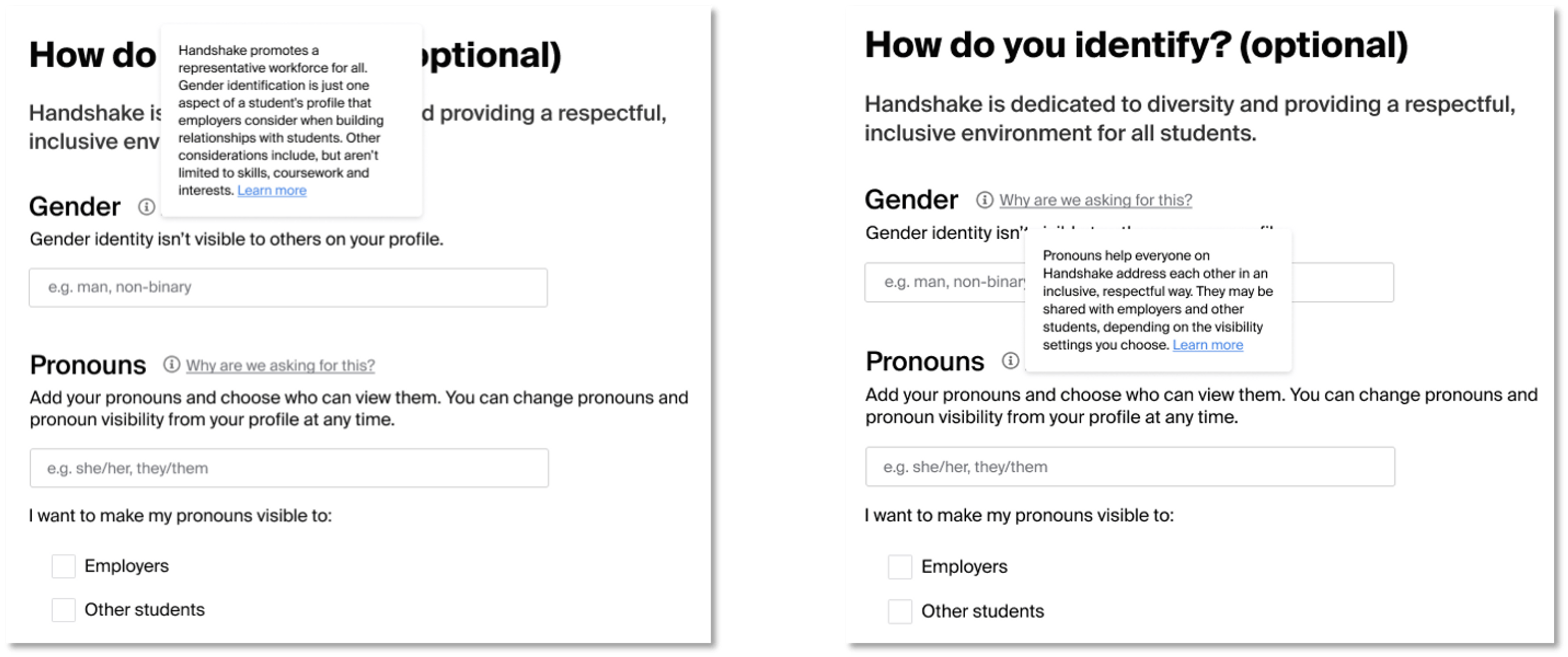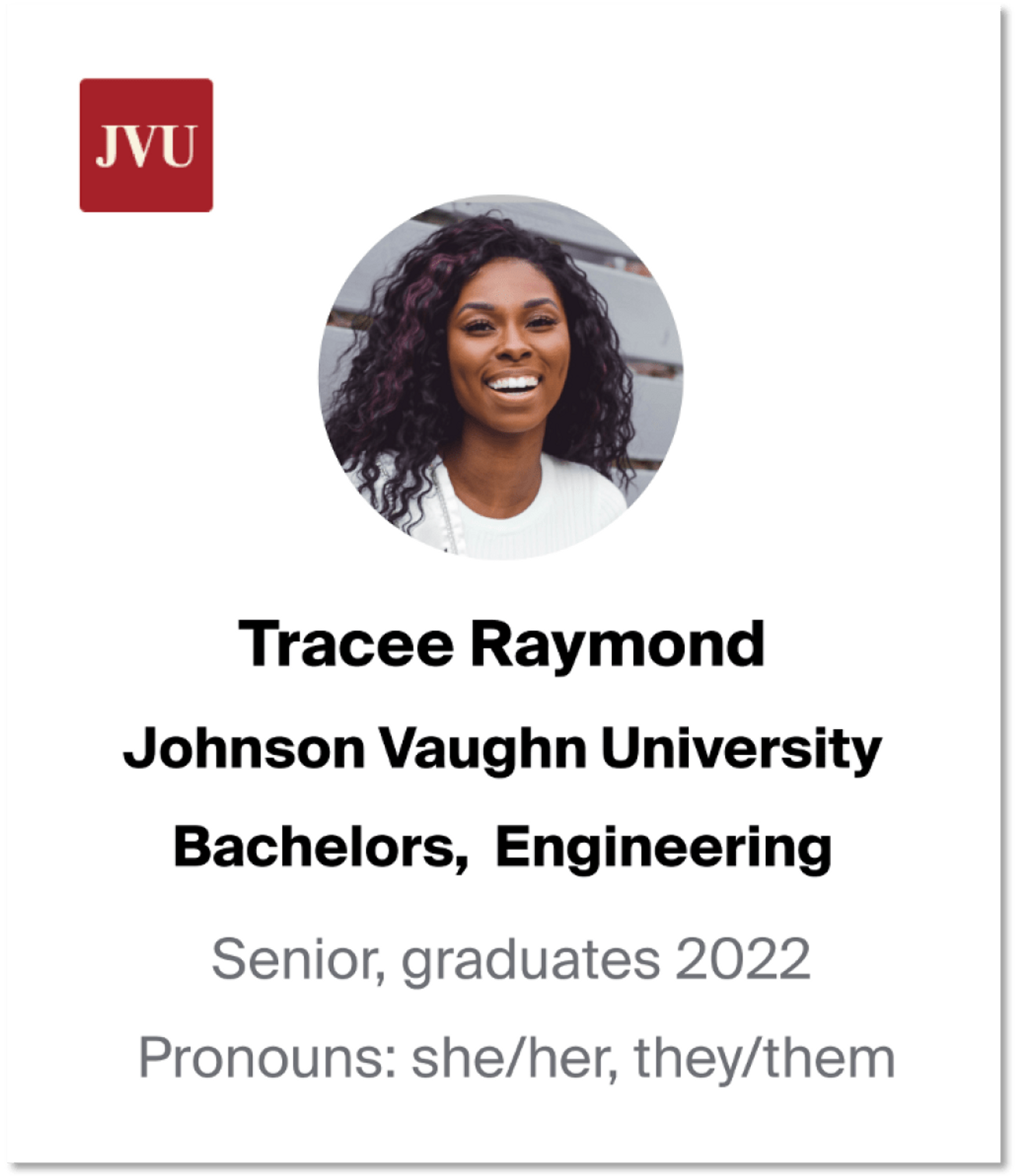We performed early research with career services staff and students across different institution types with different gender identities to inform how the feature works in Handshake. Our findings then informed our design and development.
Key research results
Our research focused on two questions:
- How can we ensure the mechanics of sharing gender identity and pronouns are inclusive?
- How can we respectfully and transparently present the option of sharing gender identity and pronouns?
Designing Inclusive Optionality
Gender identity and pronouns are expansive. Coming into our research sessions, we knew it would be important to create an inclusive design so that students would not feel othered when sharing this information. All identities and pronouns should have an equal weight of importance. It became clear that we could not design a standardized list, or hierarchy, to choose from.
Furthermore, students may also use multiple pronouns or identify with multiple gender identities. The breadth of gender identities and pronouns validated that a dropdown menu with predefined options would not fit the bill. We decided to design a field with type-ahead functionality to suggest options but not enforce them.

Type-ahead functionality for pronouns
Protecting Personal Choice Around Sharing Gender Identity and Pronouns
We also gathered feedback on maintaining transparency about where pronoun and gender information would live and who would have access to this information. Students might also not want to share at all. For many people with an underrepresented gender identity, it is a privilege to feel comfortable and safe expressing oneself so publicly, especially in a professional setting.
Contextualisation and Education
Finally, we learned that students (and employers as well) might not be versed on what gender identity and pronouns are, how to use them, or why they’re important. Providing supplemental education is critical to explain what is meant by pronoun vs gender identity and how this information is used and displayed in our product.
In Handshake, students will be given the option to share both their gender identity and their pronouns separately during onboarding. They’ll also be able to update this information via their profile. Each prompt will include help text explaining what gender identity and pronouns are and how they’re used in Handshake.

Help text provides additional context and links to Handshake's help center
Pronouns Facilitate Respectful Engagement
The ability to be addressed in a way that reflects your identity is fundamental to respectful communication—a foundation of the professionalism that we hope to foster for students seeking their careers on our platform. By adding pronouns to the profile, we hope to offer students a way to comfortably and safely start their engagement with a potential employer.

Pronouns on a student profile
After adding pronouns to their profile, a student can choose to make their pronouns visible to employers or other students to facilitate more genuine conversations. This is a separate setting from a student’s overall profile visibility.
Gender to Facilitate Equity
A growing number of employers are focused on addressing gender gaps in their hiring practices. Handshake provides an important tool for employers to foster early connections—well before an application—with students with underrepresented gender identities.
In Handshake this outreach is facilitated by allowing premium employers to create “segments”—anonymous, aggregated lists of students who are eligible to receive tailored messaging based on the employer’s chosen criteria, like schools, courses, skills or interests.
All segments used by employers on our platform follow the same principle: the employer cannot see individual students on the recipient list; they can only see an individual student’s identity if that student replies to the campaign.
Self-selected gender information is another option that can be used in this way—anonymously and in aggregate—to increase the accuracy of segments for employer messaging campaigns focused on students with an underrepresented gender identity. Still, they cannot see an individual student’s gender identity field.
Premium employers can currently send campaigns to woman-identifying students using a filter that looks for students associated with women’s colleges, woman-focused organizations, interests, and values—a method that is helpful but not all encompassing, nor 100% accurate. Adding aggregated, self-reported gender data to this feature expands the scope of students with underrepresented gender identities that employers can connect with—namely women and non-binary identifying individuals.
Note: Gender data imported by the student’s institution will NEVER be used in an employer segment or shared outside of the student’s institution in any instance, since it is not shared by the student directly.
Unlike pronouns, which are a mode of address, students cannot choose to make gender information visible to other students and employers. Even if a student chooses to self-report their gender identity, it will only be displayed to career services.
Sitting at the nexus of career services, students and employers, Handshake has the opportunity to work with our partners to chip away at gender gaps in hiring. With employers eager to reach more students with underrepresented gender identities, self-reported gender data will make it easier for employers to build relationships with more diverse and representative pools of students.
For the latest iterations of our gender and pronoun prompts, please visit the help center.
